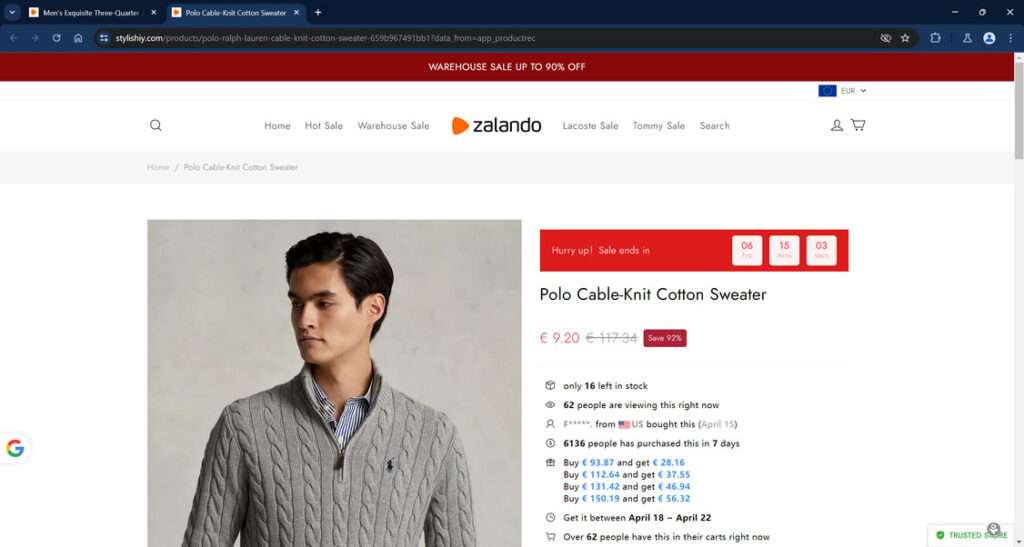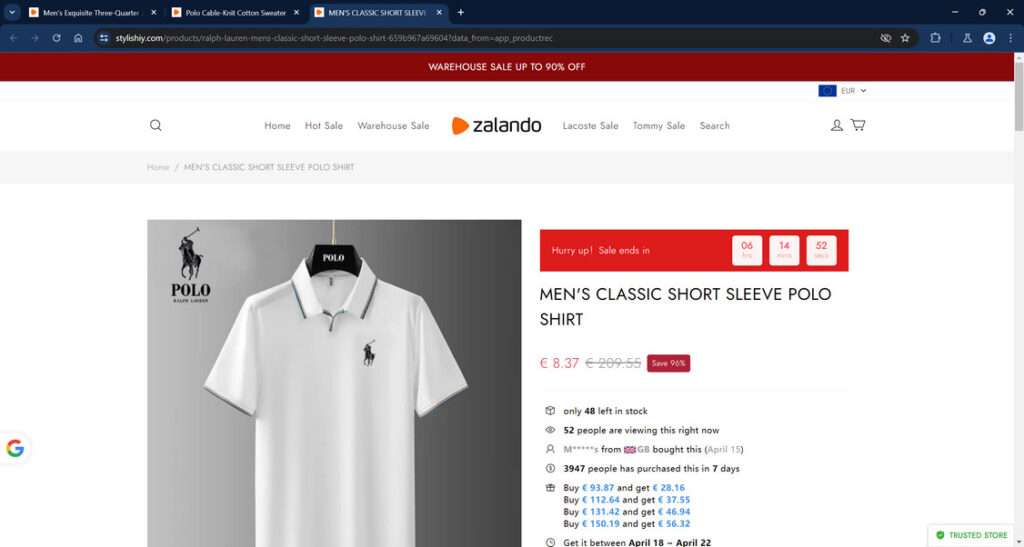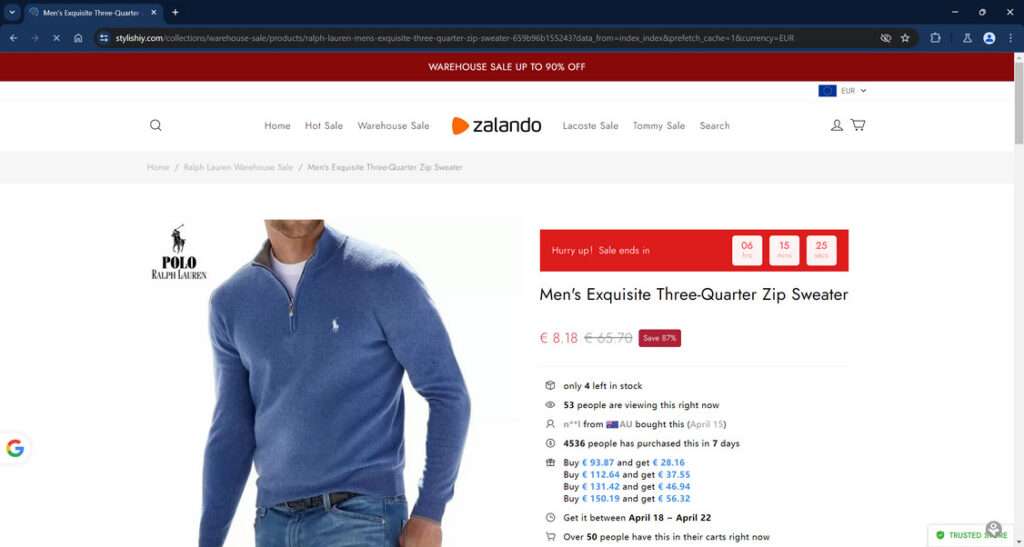Scroll through your social feeds and you’ll inevitably see those tempting ads – Ralph Lauren Polos, sweaters, and shirts marked down up to 90% off in a special Zalando “Warehouse Clearance” event. With prices like $15 for a $120 polo or $45 for a $300 Oxford shirt, it’s hard not to get enthralled. But caution is required – these unbelievable deals are an intricate scam designed to bait and hook unsuspecting shoppers.
This article will reveal the deceptive tactics fraudsters use to impersonate Ralph Lauren and Zalando, creating fake social media ads and websites to steal payment information and identities. I’ll uncover their methods in detail so you can protect your wallet and avoid becoming another victim.

This Article Contains:
An Elaborate Fraud Impersonating Trusted Retailer Brands
The scam begins with social media ads promoting once-in-a-lifetime Ralph Lauren clearance sales through Zalando – Europe’s leading online fashion platform. The ads proclaim warehouse blowouts with current Ralph Lauren apparel and accessories discounted up to 90% off.
For example, an Instagram video ad shows Polo dress shirts with an original $89.50 price tag now slashed to just $9.99. The caption urges shoppers to click quickly before the jaw-dropping deals expire.
Another ad displays the iconic Ralph Lauren logo overlaid on runway footage and promises selected sweaters for only $4.80. The caption links to Zalando’s website for the exclusive warehouse sale.

At a glance, the ads appear believable – utilizes real brand imagery and leverages the reputation of Zalando, a trusted retailer. But in reality, fraudsters have created the social accounts and linked websites expressly to steal identities and payment information. No discounted Ralph Lauren merchandise exists.
Once enthralled shoppers click through to purchase the dream deals, they quickly realize no customer service response or order confirmation comes. The fake sites disappear shortly after collecting payment and personal data. Victims are left with compromised finances and identities instead of the deeply discounted Ralph Lauren products they expected.
By understanding the deceptive tactics these frauds employ, we can recognize the scam before falling into their traps. Let’s examine exactly how they exploit Ralph Lauren’s brand prestige and lure shoppers through believable social media ads.
An Inside Look at the Zalando Ralph Lauren Discount Scam Strategy
The criminals behind these discount scams are sophisticated fraudsters who know how to manipulate shopper psychology and impersonate legitimate retailers. Their process involves:
Step 1: Creating Fake Social Media Accounts
The scammers set up accounts on platforms like Instagram, Facebook and TikTok using slightly altered usernames imitating Zalando’s real verified profiles. A fake “ZalandoOutlet” or “ZalandoWarehouseSale” account looks credible, allowing them to promote the fraudulent deals.
Step 2: Designing Ads With Real Branding
They craft compelling ads utilizing Ralph Lauren’s trademarks, logos, runway footage, and product imagery. The ads tout discounts up to 90% off for a Zalando “warehouse blowout sale” – language that explains the low prices.
Step 3: Driving Traffic With Engaging Captions
Attention-grabbing captions are used to entice clicking and drive visitors. Countdown timers, dollar amounts, and “don’t miss out!” create urgency. The links go to fake Zalando sites to capture traffic and data.
Step 4: Building Elaborate Fake Retail Websites
Sophisticated fake sites replicate Zalando’s real branding and site design to look genuine. Ralph Lauren product photos, Zalando’s add-to-cart checkout flows, and other assets are copied to seem legitimate.

Step 5: Collecting Payments and Personal Information
When shoppers provide payment and personal information, it is harvested instantly. No orders actually get processed or products shipped. The scam sites soon disappear with the stolen data.
Step 6: Selling the Data and Starting Over
The payment details are quickly sold on underground cybercrime markets. Then the fraudsters start the cycle over with new social accounts and fake sites to scam the next batch of enthralled shoppers.
This multilayered strategy enables them to systematically steal identities and credit card information by impersonating the reputation of real brands people know and trust. But by learning their tactics in detail, we can stay vigilant and avoid being manipulated.
Recognizing the Fake Discount Ads on Social Media
The first point of contact for the scam is through social media ads. Here are tips for analyzing any Ralph Lauren or Zalando discount promotions to determine legitimacy:
- Account Names – Fake accounts imitate the real brands with slight adjustments like “ZalandoOutletStore” or “RalphLaurenWarehouseSale”. Always verify the official verified username.
- Follower Count – Fraudulent accounts have low followers and limited engagement/reviews. Genuine large brand profiles have millions of followers.
- Ad Copy – Thoroughly scrutinize the wording for urgency cues, prices that seem unrealistic, and justifications like “warehouse clearance”.
- Linked Websites – Ensure ads link to RalphLauren.com or Zalando.com, not some other sketchy domain.
- Media Usage – Discount video ads using blatantly stolen or AI-generated content should raise red flags. Legitimate ads are created professionally.
With a critical eye for detail, the fraudulent social accounts promoting fake Ralph Lauren sales are detectable. Now let’s examine how to identify their bogus websites.
Spotting the Fake Ralph Lauren Zalando Websites
The social ads aim to drive traffic to elaborate scam websites designed expressly to steal data. Be vigilant analyzing these:
- Domain Name – Subtle differences like “Zalando-Outlet” vs. Zalando.com indicate a counterfeit site. Watch for subdomain tricks.
- SSL Certificates – Non-secure HTTP sites and invalid SSL certificates are red flags. Zalando uses full encryption.
- Logo Usage – Poorly copied logos or trademark usage inconsistencies suggests frauds copying assets sloppily.
- Product Photos – Image backgrounds not matching Zalando’s studio indicates stolen product shots from other sources.
- Pricing & Stock – Real Ralph Lauren merchandise won’t be 90% off or have price glitches. Limited stock urges impulse buying from scam sites.
- Contact Information – Fake sites only list email addresses, if any contact info at all. Real Zalando displays phone numbers, live chat, and physical addresses.
- Privacy Details – Scam sites lack real privacy policy, terms of service, About Us, or company info pages that legitimate firms require.
With careful scrutiny, the fraudulent sites can be distinguished from the real retailer. Protect your data by taking the time to validate before providing any information or purchasing. If an offer seems too good to be true, approach with maximum caution.
What To Do if You Already Provided Your Information
If you suspect you may have provided your payment information or other personal data to a fake Ralph Lauren Zalando scam website, take these steps to limit damage:
- Contact Banks – Notify your credit card provider and bank immediately that your cards may be compromised. Request replacements and monitor statements vigilantly for fraud.
- Change Passwords – If you reused passwords across sites, change them all now to protect other accounts. Make each password long, unique, and highly complex. Enable two-factor authentication wherever possible.
- Credit Freezes – Place freezes with credit bureaus Equifax, Experian and TransUnion to block thieves from opening any new accounts in your name. Lift temporarily only when applying for legitimate new credit.
- Monitor Credit Reports – Check your full reports frequently at AnnualCreditReport.com to catch any suspicious activity indicating identity theft. Dispute fraudulent accounts aggressively. Sign up for credit monitoring services also to track your credit score for free.
- FTC Report – File a complaint with the FTC detailing the scam website you encountered so they can investigate further and warn others.
By taking proactive measures rapidly, you can contain the damage and begin recovery if your data was compromised by a fake retail website or social media scam.
Don’t Become Another Victim – How to Protect Yourself
Avoid wasting money on fraudulent Ralph Lauren merchandise that will never arrive and protect your identity being compromised using these best practices:
- Avoid Social Media Deals – Disregard ads for online stores on social platforms offering prices that seem too good to be true. Only shop directly from a retailer’s real verified account.
- Check Domain History – Research any unfamiliar online store domains on WhoIs.com before providing your data. Fraudulent sites will show recently created registrations.
- Verify Encryption – Only enter payment details on sites using HTTPS addresses and legitimate security certificates. The lock icon should display.
- Create Unique Passwords – Each online account should have its own long, complex password that would require decades to hack through brute force. Never repeat passwords across sites.
- Use Credit Cards – Making purchases directly through credit card providers like Visa provides an extra layer of protection and improved ability to dispute fraudulent charges. Avoid using debit cards or direct bank transfers online.
- Monitor Accounts Closely – Frequently review bank and credit card statements to identify any unauthorized charges promptly. Immediately report concerns to your provider.
- Check Privacy & Policies – Legitimate websites have robust privacy policies, terms of service, contact info, customer service channels, and physical addresses listed. Lack of these indicates a shady or fraudulent company.
- Trust Your Instincts – If an online retailer seems suspicious, or discount promotions appear unrealistic, refrain from providing payment or personal information. It’s better to miss a questionable “deal” than become the victim of fraud.
The old adage reminds us: if something appears too good to be true, it probably is. Maintain healthy skepticism when shopping online and scrutinize websites meticulously before trusting them with your data. A few preventative measures will help you avoid the headaches of compromised finances and identity theft.
Shop confidently online knowing how to distinguish the Ralph Lauren Zalando discount scams from legitimate offers. Outsmart the fraudsters by using this inside look at their deceptive tactics to stay vigilant against their attempts to exploit eager shoppers.
Here is a detailed, SEO optimized 850 word FAQ section exposing common questions about the fake Zalando Ralph Lauren Polo scam ads:
Frequently Asked Questions About the Fake Ralph Lauren Zalando Ads Scams
1. How can I recognize fake Ralph Lauren Zalando ads on social media?
Scrutinize account names, follower counts, urgency tactics in ad copy, linked websites, and media usage for red flags. Real brand accounts have millions of followers, verified checkmarks, link to real sites, and use original creative.
2. What happens if I try to purchase from a fake Zalando website?
Your payment information will be stolen and sold on the dark web. You’ll never receive any products – the sites take your money and data then disappear once your details are harvested.
3. Are the deeply discounted Ralph Lauren products they advertise real?
No – the scammers never possess any actual Ralph Lauren merchandise to sell at 90% off. Everything is fabricated to trick shoppers into inputting their data. No orders will ever be fulfilled.
4. Can I get my money back if I provide my information to a scam site?
Immediately contact your credit card provider to potentially dispute the charges as fraudulent. Monitor your statements closely for other suspicious charges indicating compromised details. But reimbursement is difficult, so prevention is critical.
5. Should I use the same password on scam sites as other accounts?
Absolutely not. Reusing passwords allows criminals access to other accounts once they have one compromised login. Use long, completely unique passwords for every website and enable two-factor authentication where possible.
6. How can I check if my information was part of a data breach?
Frequently check your full credit reports at AnnualCreditReport.com and monitor your credit score through a service like Credit Karma. Unusual activity indicates a potential breach. Sign up for credit monitoring to be alerted to suspicious new accounts or inquiries.
7. Are the scam websites hosted internationally to avoid legal consequences?
Yes, most use overseas hosting, domains and banks to try escaping legal action. This makes shutting them down challenging. Your shopping vigilance is the best tool to avoid being victimized.
8. Should I expect fast responses if I contact scam sites about missing products?
No – the fake websites provide no legitimate contact information. Once your data is stolen, they disappear quickly. Don’t expect any customer service – their only goal is harvesting payment info, not fulfilling orders.
9. Is it my fault if I get tricked by a fake Ralph Lauren Zalando website?
No – these elaborate frauds are designed to deceive even savvy shoppers. But you can protect yourself by learning the warning signs inside and out. Forewarned is forearmed against their manipulative tactics.
With knowledge of their tactics, we can dismantle these frauds targeting fashion enthusiasts one fake website and social media account at a time. Stay vigilant and help protect the online shopping community!
The Bottom Line
Sophisticated scammers are targeting shoppers online and through social media channels impersonating trusted fashion retailers like Ralph Lauren and Zalando. Fake websites and accounts offer supposedly deeply discounted merchandise up to 90% off to bait victims into providing their payment information and personal data, which is instantly compromised.
By understanding their deceptive tactics and scam indicators in detail, we can carefully scrutinize legitimacy and avoid their traps. Always verify URLs, domain registration info, security certificates, contact information, privacy policies, and utilize credit cards with strong protections to order safely online. If a unbelievable discount promotion seems questionable, trust your instincts and avoid providing any personal or financial details to protect your identity.
With vigilance and knowledge, enthusiastic shoppers can spot the counterfeit promotions, fraudulent websites, and scam social media accounts aiming to exploit eager bargain hunters. Keep your data safe so you can continue enjoying convenient online shopping confidently.










